 On photos AS16-113-18339 and AS16-113-18340, the photographer catches twice the commander Young as he jumps and salutes the flag. On the second photo we can see that the camera makes a slight rotation relatively to the first photo. |
 But the camera is not the only one to make a rotation. We can see that the astronaut also makes a rotation on the second photo which is different from the one we see on the first photo. This is visible because the angle his legs make with the lem's shadow is not the same on the two photos. Assuming that the astronaut's orientation was vertical on the first photo, it is not on the second photo. Yet, when you fall down, the attraction always forces your orientation to be vertical, and it is as true with the moon's attraction as it is with the earth's one, even though the moon's attraction is six times lesser than the earth's one. On this GIF showing the two jumps of the astronaut, if you look attentively, you can see that the astronaut doesn't fall the same way on the two jumps. |
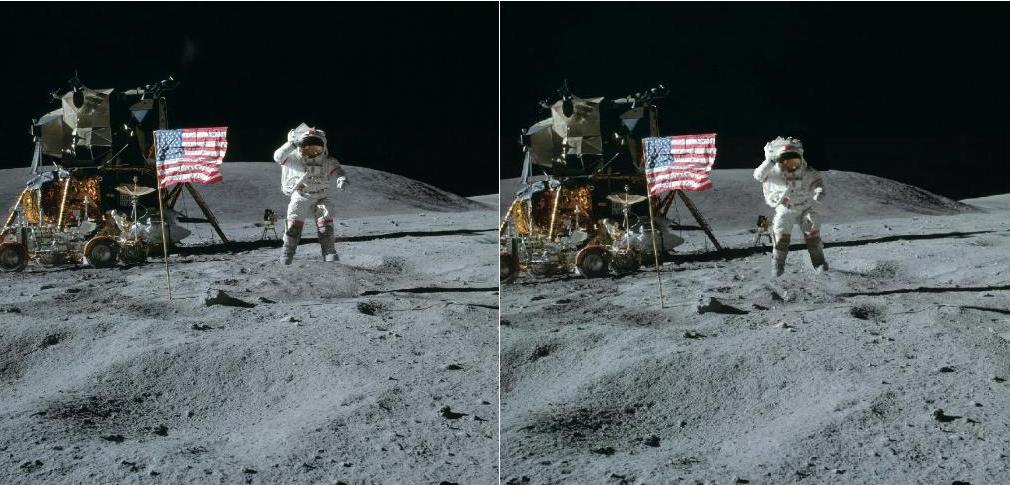 On this double view, I have corrected the astronaut on photo AS16-113-18340 (the photo on the right) to give him the same orientation as the one he had on photo AS16-113-18339 (the photo on the left). |
This animation is made with the photo AS16-113-18339 and the original photo AS16-113-18340 (i.e. the astronaut not falling vertically the second time). |
And this animation is made with the photo AS16-113-18339 and the photo AS16-113-18340 I corrected (i.e. the astronaut falling vertically both times). |
 And how did the photographer do to reach the point where he took the photographs from? On the ground you can see that there is not the least footprint. Did he fly to reach this point? |
 On photo AS16-113-18341 (right), the other astronaut is photographed in his turn. You can see that this time there are plenty of footprints, and some strangely shaped or strangely oriented. |
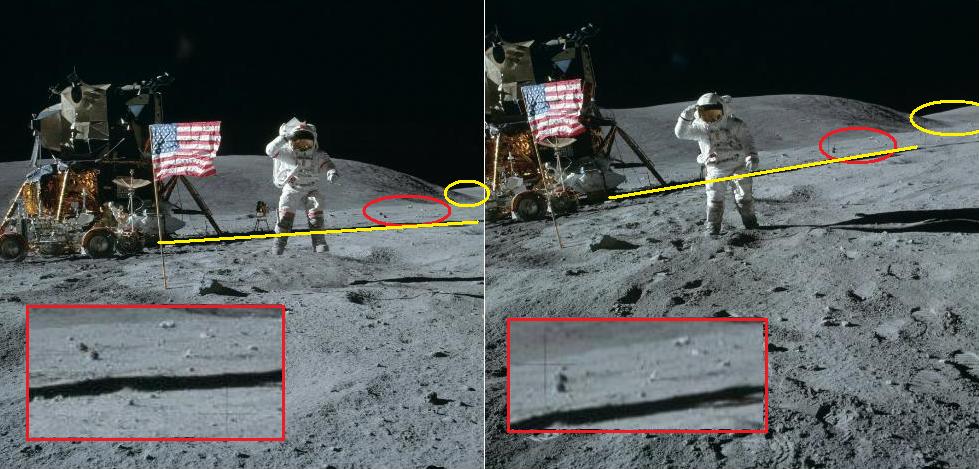 There is a slight rotation of the camera relatively to the previous photograph. If we consider the orientation of the lem's shadow (I have outlined it in yellow), and also the fact that we see more of the hill I have circled in yellow, this rotation is clockwise. But if we attentively look at the artifacts in the background near the hill (I have circled them in red, and I show a close-up of them in a window bordered with red), they show an counterclockwise rotation of the camera, that is a rotation which is opposite to the previous rotation! It must be a lunar rotation! |
There are three photos AS16-113-18341, AS16-113-18342, and AS16-113-18343 showing the second astronaut(Charles Duke). Here is an animation made with these three photos. If you look attentively, you can see that there is something which distinguishes one photo from the two other ones. There are sun reflections which appear on the visor and the camera of the astronaut on this photo, and which are not present on the two other photos. |
 Here is a double view of the astronaut on the two first photos. I have circled the sun reflections which appear on the second photo. The first impression is that the reflections are missing on the two other photos because the astronaut was shielding the sunlight with his hand. |
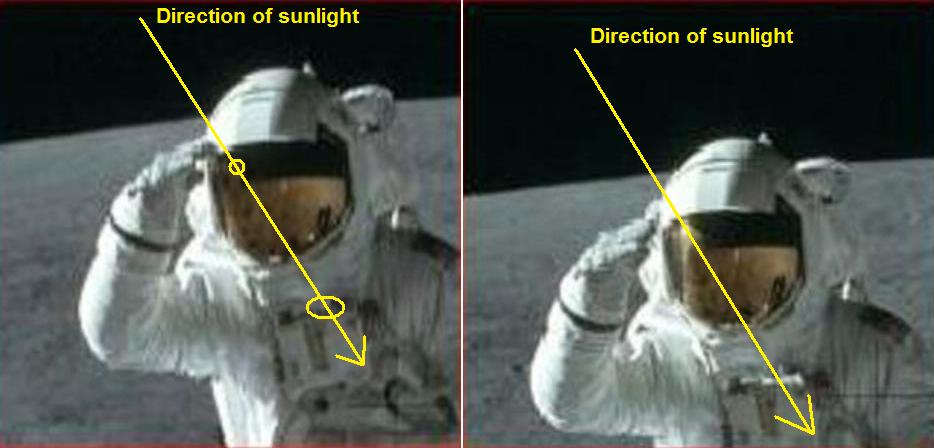 If we make a close-up of the astronaut, we can see that the direction of the sunlight, that we can reconstitute as going from the reflection on the visor to the reflection on the camera, is well ahead of the astronaut's hand. I show with yellow circles the location of these reflections on the first photo (where these reflections are missing), and we can see that the astronaut's hand can't shield the sunlight; these reflections should also be present on the first photo. |
 If we look in the visor of the astronaut on the three photos, we see strange things. On the left I identify what seems to me the paw of an animal (a tiger's paw?). There is also a strange face, a lunar face I should say! |
 On the second photo that the astronaut is caught saluting while he jumps, there is a hole which appears under the astronaut. |
 On the photo with the other astronaut, if we take a new close-up at the zone where there has been the creation of a hole, we can see that our hole has moved forward. It's a hole which likes to travel! |
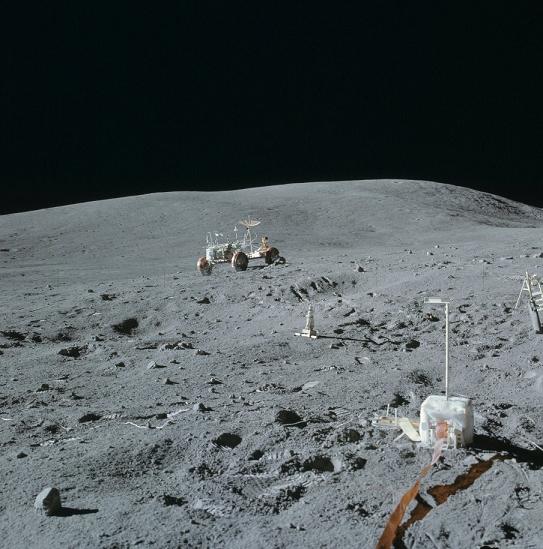 The hill which is behind the astronaut looks darker than the foreground; yet the direction of the shadows shows that the sun is not shining in its back. And there is even another photo on which this hill is as clear as the foreground. It must be a hill with variable luminosity, an exclusivity of the moon! |
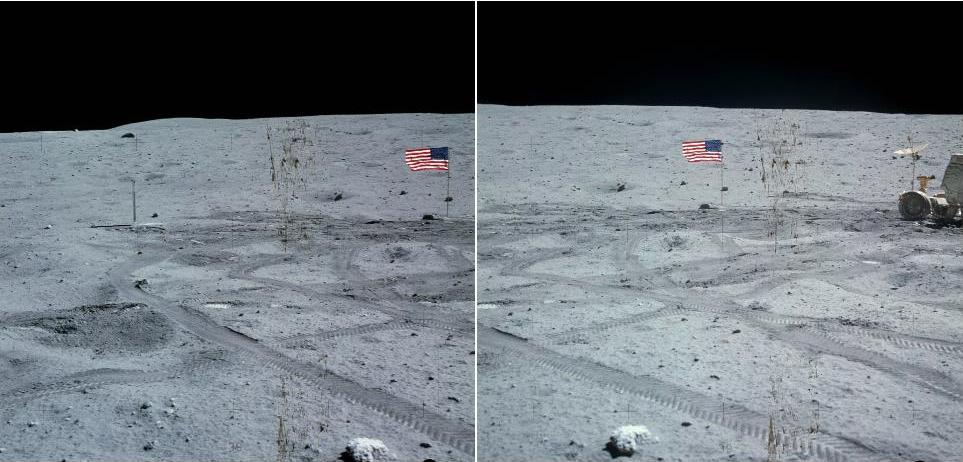 Suddenly I came across this (photos AS16-116-18574, AS16-116-18575). There is on these photos what appears to be mud spots! You find the identical mud spots on some other thirty photos of the mission (some examples: AS16-114-18455, AS16-114-18453, AS16-116-18576, AS16-116-18577, AS16-116-18578...) |
And if you think it might be a defect of the film, I'll tell you that, if it had been a defect of the film, it would have been erratic, random, not repetitive like on the photos. This animation made with three consecutive pictures (AS16-116-18575 to AS16-116-18577) shows the repetitivity of the mud spots. And the photos which follow show the same mud spots. |
 Here on these two photos (AS16-106-17241 and AS16-106-17257), we have two views of a hole taken at different distances. The background has moved up (which means that the photographer has a little turned his camera toward the ground), but the foreground has more moved up that the background, which means that the photographer has backed up (for, if he hadn't, the foreground would have moved up the same as the background).  Here on this couple of photos, I have placed colored boxes down on the ground, and I take photos from a height. I take the first photo close to the edge, and then farther from it. On the first photo, the colored boxes are at some distance from the edge, and on the second photo, they are close to it. This comes from the change of angle of view created by the fact that I have backed up. 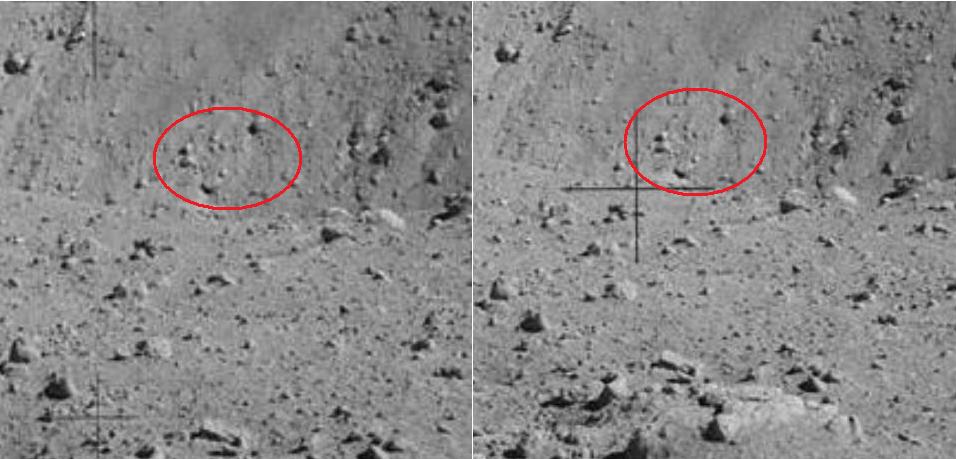 But on the apollo photos, although the hole is seen under a different angle of view in reason of the fact that the photographer has backed up, we see exactly the same group of stones immediately close to the edge of the hole. |
 On this photo (AS16-106-17336), the photo is taken from up, but the astronaut who is photographed is not looking up. Therefore we should not see the photographer in the reflection of his visor, or only on the extreme top of it...Yet we see him, not far from the middle of the visor (I have circled him in red)!  On the view of the left, I show how the photographer appears on the visor, and, on the view of the right, I show the only way he could have appeared (supposing that he even appeared at all!). |
 On photos AS16-106-17415 and AS16-117-18729, we have two views of a rock.  But if we take a close-up at the bottom of the rock, we see something abnormal. You don't see it?  Let me help you. The parts I have colored in yellow are different on the two photos (and weird too!). |
 The photos AS16-107-17434 (left) and AS16-113-18329 show two views of the lem. The leg which is on the left on the first photo is the same as the one which is on the center on the second photo.  If we take a close-up at the foot of these legs on the two photos, we can see that the orientation of the footpad is completely different! |
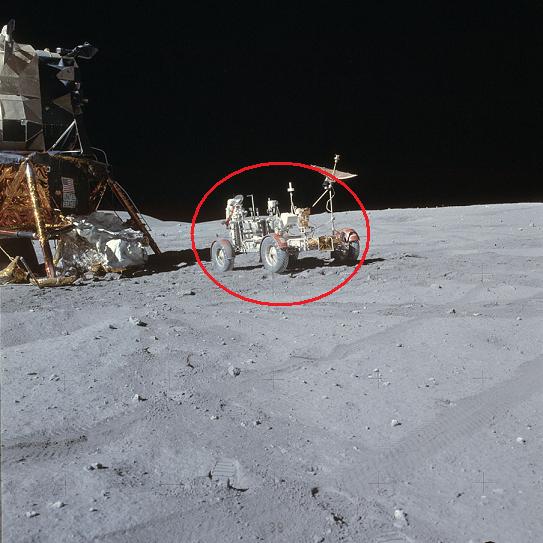 On the photos AS15-107-17437 and AS15-107-17438, we can see the astronaut move behind the rover.  But if we take a close-up at the scene, we can see that the astronaut is broader on the second photo than he is on the first photo. |
 On photo AS16-107-17439, the flag is not oriented the same as on the photo on which the astronaut salutes the flag (AS16-113-18339). We can see that its orientation relatively to the stone which is at its foot is different. |
 On photo AS16-107-17441 (photo on the left), we see a lunar probe which stood up after the touch down. On the photo AS16-107-17442, we have turned around this lunar probe. In the zone I have circled in red, and of which I show a close-up in a window, we can see a triangle which is around the lunar probe, and which is totally useless. But, what is really surprising is that we can see a bent nail which goes through the lunar probe; it has no function in this lunar probe. |
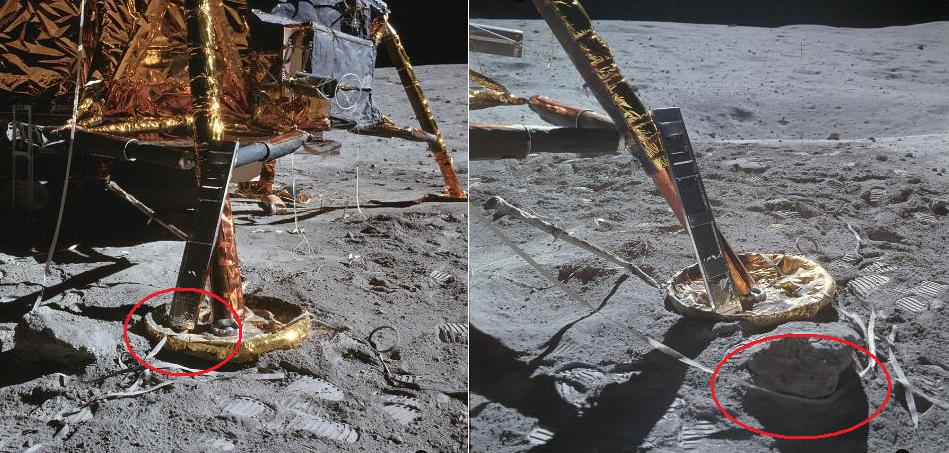 On photo AS16-107-17441, a white ribbon passes over the Lem's foot. But on photo AS16-107-17442, the same ribbon passes behind a rock which is near the Lem's foot instead! |
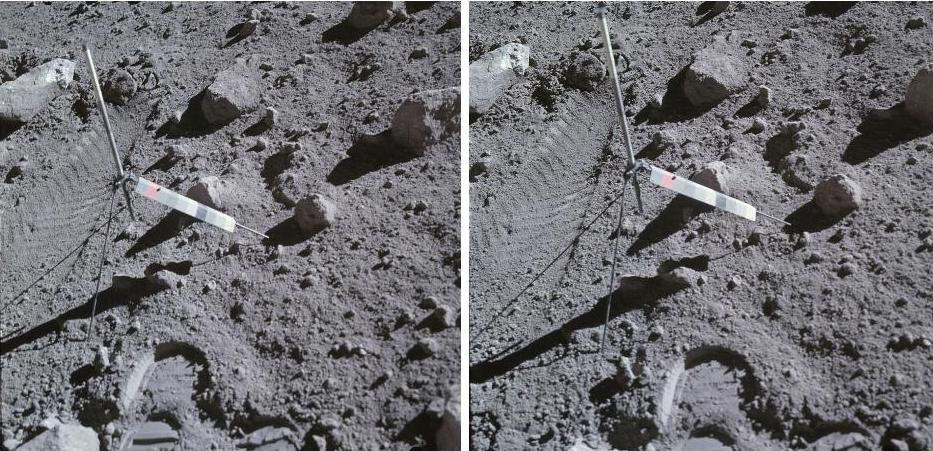 On the photos AS16-107-17443 and AS16-107-17444, we have two views of a tripod.  On the first photo, we can see the third leg of the tripod (the farthest from the photographer), and on the second photo, we can't see it any more. If we judge by its shadow, it's perfectly hidden by the left frontal leg.  Now look: On the photo of the left, there is the tripod of the Apollo photo with the left leg perfectly hiding the third leg. On the photo of the right, there is my tripod with the left leg also perfectly hiding the third leg. Don't you notice something? The orientation of the left leg in completely different! And it's only when the tripod has his left leg oriented as it is on my photo that this leg can hide the third leg.  Now I have given to the left leg an orientation closer to the left leg of the Apollo photo: You can see that the third leg is now well visible: With this orientation of the left leg, it can't hide the third leg.  In fact the third leg of the tripod on the Apollo photo has a completely wrong orientation. With this orientation of the left leg, the third leg should approximately appear like the line I have drawn in red. In any case, the left leg couldn't hide the third leg with the orientation it has.  On this photo the orientation of the third leg is so wrong that, with a such orientation of this leg, the tripod would be unstable and would fall down! It's not the only incoherence you can find on these photos. There's also a problem with the shadows. 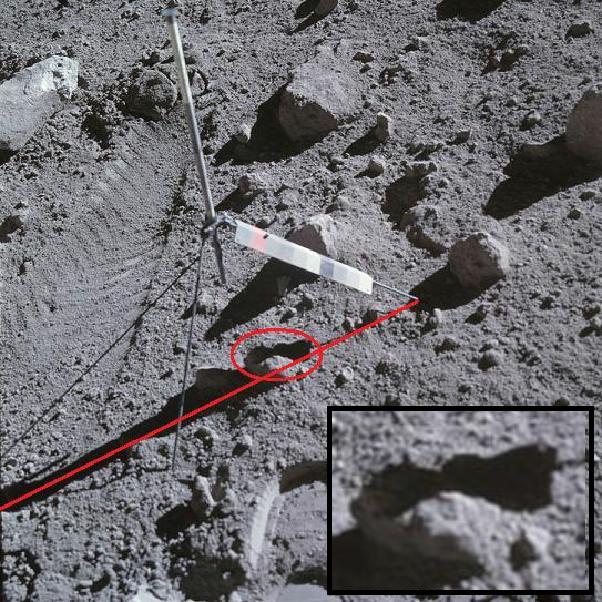 On this photo I have circled a part of the multi-colored strip's shadow (of which I show a close-up down of the right) which behaves strangely. It suddenly diverges from the direction of the shadow of this leg (the line drawn in red). Effectively the relief could make the shadow diverge, but here it starts diverging from a flat area, it doesn't diverge on a rock (although there's a rock nearby, but it doesn't create the divergence). We also see that this diverging part brutally stops, and it also stops on a flat area, not on a rock. 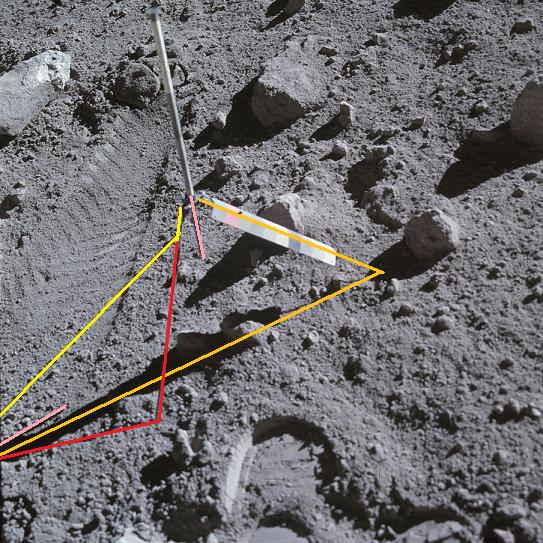 Here I show the legs of the tripod and their shadows with different colors (and also the central column). Normally the shadows of the legs (and the one of the central column) should meet on a common point.  But when we prolong the shadows of the legs, we can see that there is one which doesn't meet with the common point of the others. |
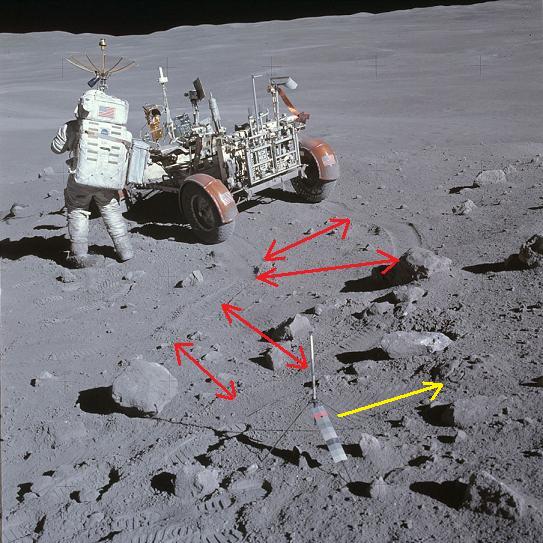 On photo AS16-107-17446, the tracks of the Jeep are obviously not parallel. And there also is a rover track which leads to nowhere! |
 Between photos AS16-107-17451 and AS16-107-17452, the scene makes a translation combined with a rotation. If we look at the two photos through an animation, we have the feeling of something strange.  This comes from the fact that the rover track on the right rotates more than the rest of the scene. If we draw a line between two same rocks on the two photos, we find a rotation of only 6° for that line between the two photos. But for the Jeep track, we find a rotation of 19°; that's a lot more! |
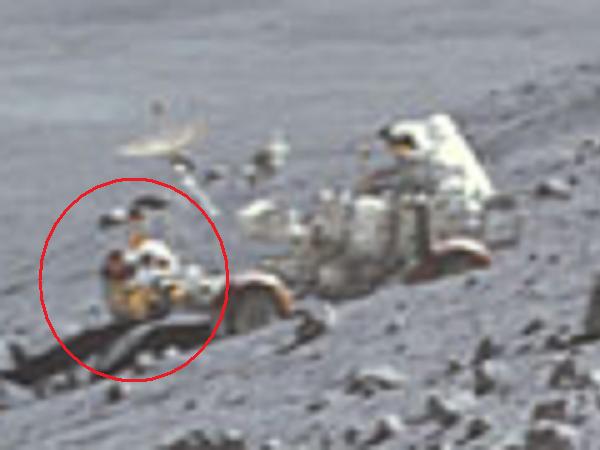 If we make a close-up of the Jeep on photo AS16-107-17473, we see something strange on the front of the rover! Pluto aboard? |
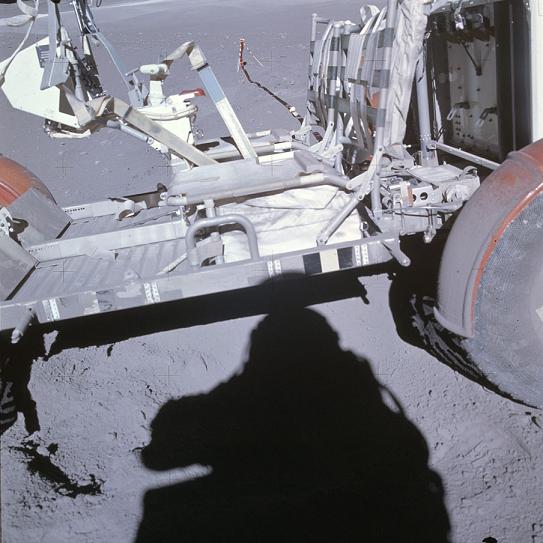 On photo AS16-107-17511 (Figure F.20), the photographer’s shadow is on the middle of the photo and yet has a strong profile. |
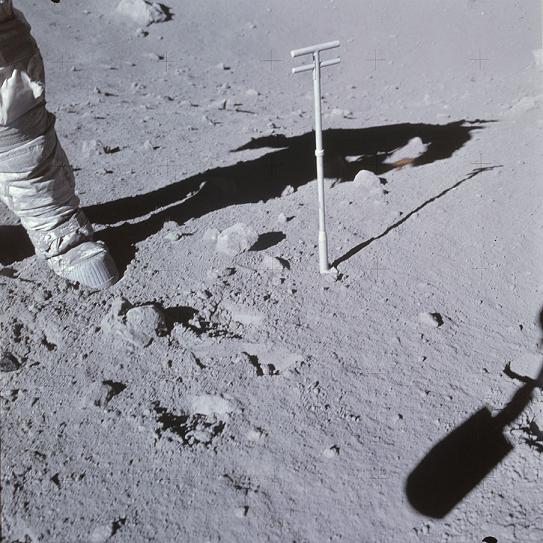 On photo AS16-107-17517 (Figure F.21), the photographer’s shadow is out of view, but we can see the shadow of the spade he is holding which shows that his shadow is on the right of the photo; thence he has the sun on his left. The shadow of the other astronaut seems to be correctly oriented, but, what’s wrong is that this shadow covers a stone which should normally be shaded, and this stone is abnormally lit. Concerning the photographer, with the spade he is holding, and that he must even hold with both hands since it is horizontal, we can wonder how he managed to take the photo. Ah, these lunar elves! they come very handy to take the photo when no astronaut is available to take it! |
 On the photos AS16-107-17577 (left) and AS16-107-17579 (right), we see a bit of lunar soil which has been cut with the scoop (that we see put on the rock on the photo of the right).  On these close-ups, we can better see the bit of lunar soil which has been cut by the scoop (I have circled it in red on the two close-ups). We can see it under two different angles on the two photos.  But an extremity of the bit faces a side of the hole which appears to be different on the two photos. |
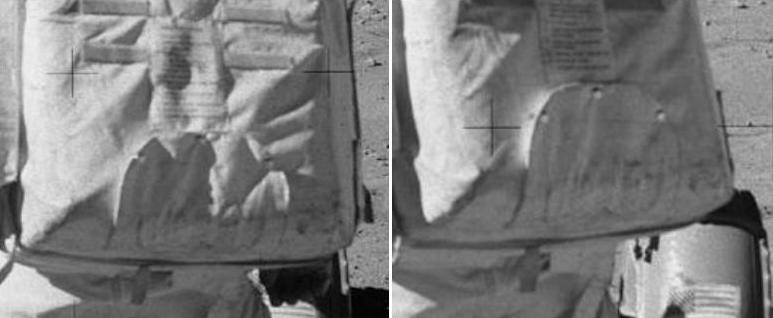 On the photos AS16-108-17622 and AS16-108-17623 we can see something written on the backpack of the astronaut, but I can't make out what it is. Can you? |
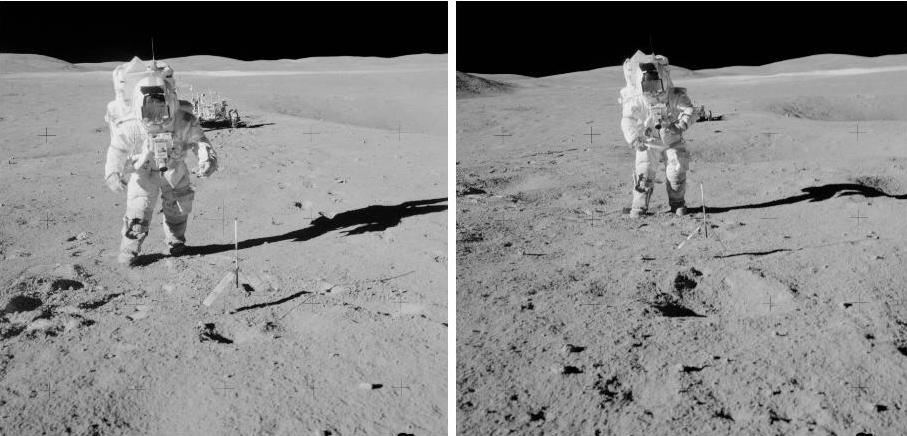 On photos AS16-109-17797 and AS16-109-17795, we can see two views of an astronaut with his rover behind him. On one photo the astronaut looks bigger than on the other photo. If we make an animation with these two photos, that makes a comical effect. One might think that if the astronaut and the rover were looking smaller on the second photo, it's simply because they are taken from farther away, and so the apparent anomaly would be normal. But is it really the case? Are the astronaut and the rover of the second photo compliant with the ones of the first photo but taken from farther away? We are going to see that!  Here we have a little table taken at two different distances.  If I magnify the second photo, I can obtain a table of the same sizes as the one of the first photo. If the orientation of the table on the two photos was the same, I could perfectly superpose the tables of the two photos after I have resized the one of the second photo. 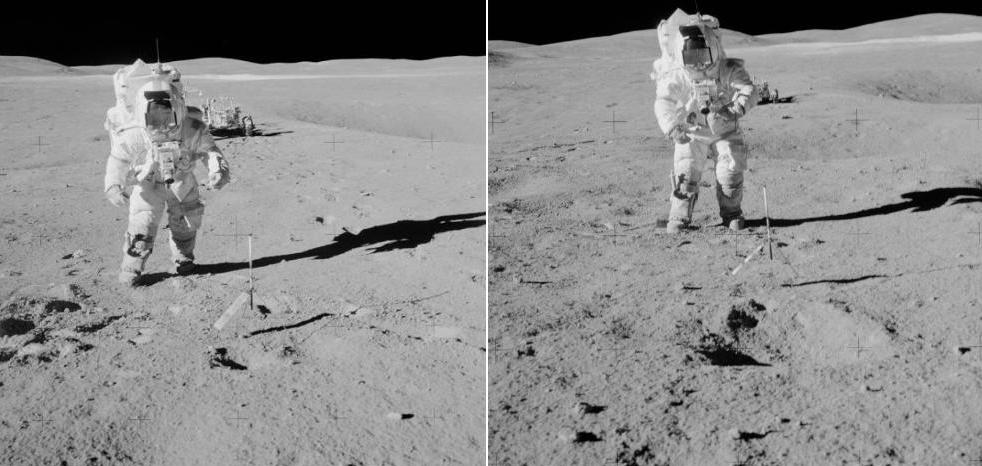 If I magnify the astronaut of the second photo, he doesn't look like the one of the first photo; I couldn't superpose the two, the one of the second photo is thinner, he has a ratio Width/Height different.  And if the rover was really smaller because taken from farther away, it would be higher on the second photo, closer to the horizon line, like this bike taken at two different distances. On the Apollo photos, the two rovers are at the same height on the two photos, the same distance from the horizon line. The situation would be normal if we were seeing the smaller rover of the second photo higher on the photo, closer to the horizon line, like in this animation in which I corrected the rover of the second photo to put it higher on the photo, closer to the horizon line. So this animation isn't just amusing, it's also abnormal. |
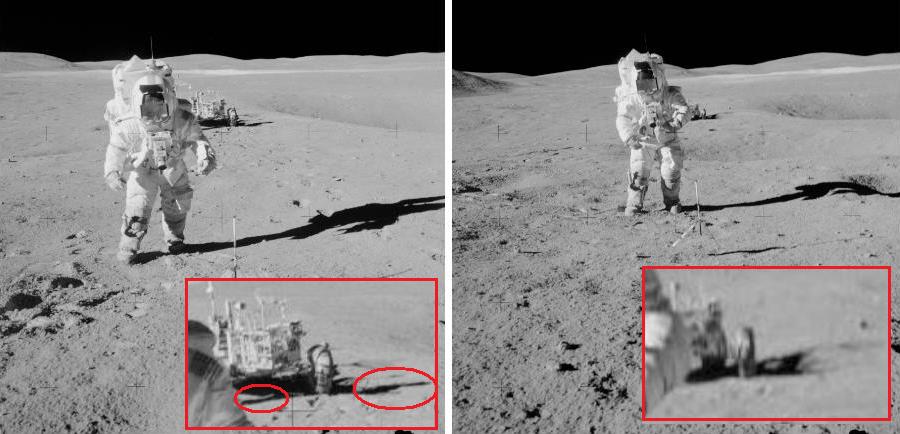 On photo AS16-109-17797 (left), there is a shadow which appears in front of the rover which doesn't belong to the rover, as we don't see it on the other photo; yet it can't be the shadow of the other astronaut as he is currently taking the photo! |
 Between these two pictures (AS16-110-18006 and AS16-110-18007), the intensity and the direction of the sunlight changes a lot! |
 On photos AS16-113-18349 and AS16-113-18350, the astronaut is taking a photo of a ribbon which is stretched obliquely. Between the two, the photographer turns his camera on the right; this pushes his shadow on the right, too. At first view, the sequence looks normal. |
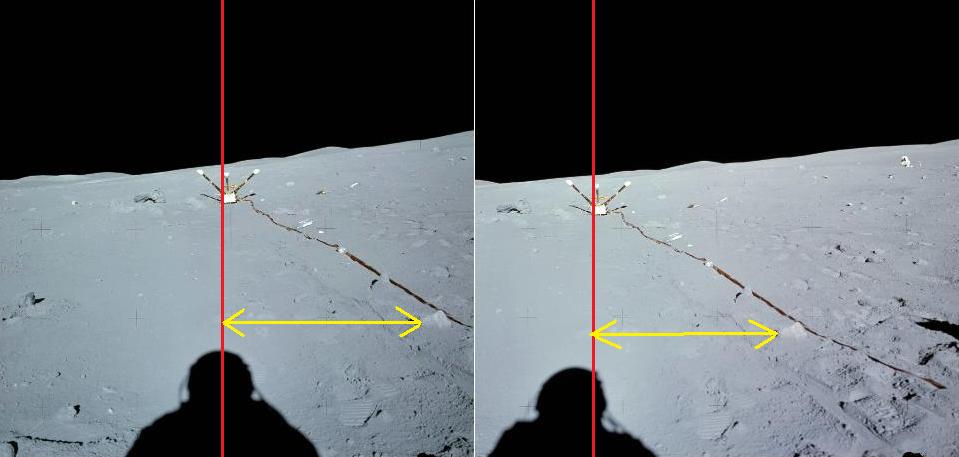 But if we draw a (red) line from the magnetometer, we can see that it cuts the shadow of the photographer differently; relatively to the magnetometer, the shadow has moved on the left. If the photographer had only made a rotation with his camera, the red line should cut the shadow the same way; but we can see that there is a stone near the ribbon and closer to the photographer which has moved on the left relatively to the magnetometer; it indicates that the photographer has moved on the right, and, if the photographer has moved on the right, not only his shadow should not have moved on the left relatively to the magnetometer, but it should even have moved a little on the right! |
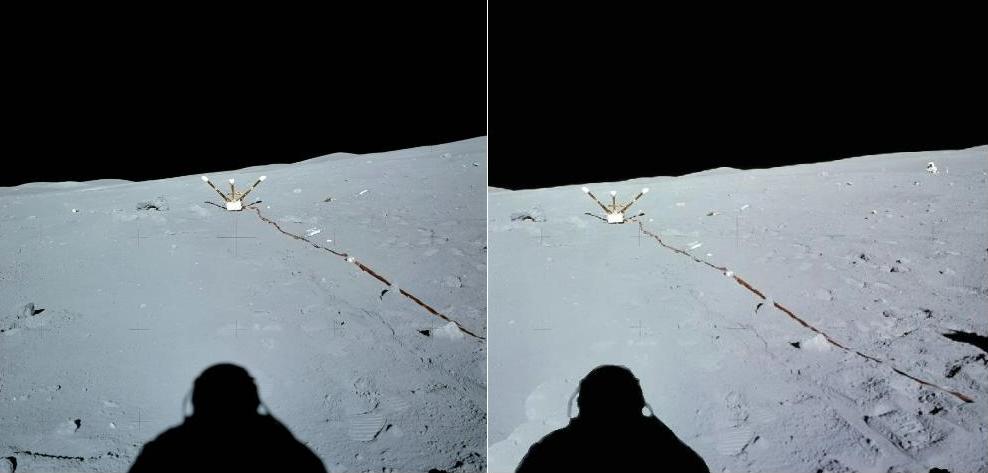 I have modified the position of the photographer's shadow on photo AS16-113-18350 (on the right) to make it coherent with the shadow on photo AS16-113-18349 (that is pushed slightly on the right relatively to the magnetometer). |
 On the photo AS16-113-18353 we can see a strange thing in the distance.  If we make a close-up on this strange thing, we can see what appears to be two astronaut toys side by side! In fact, if we look attentively, we even can see two of them. |
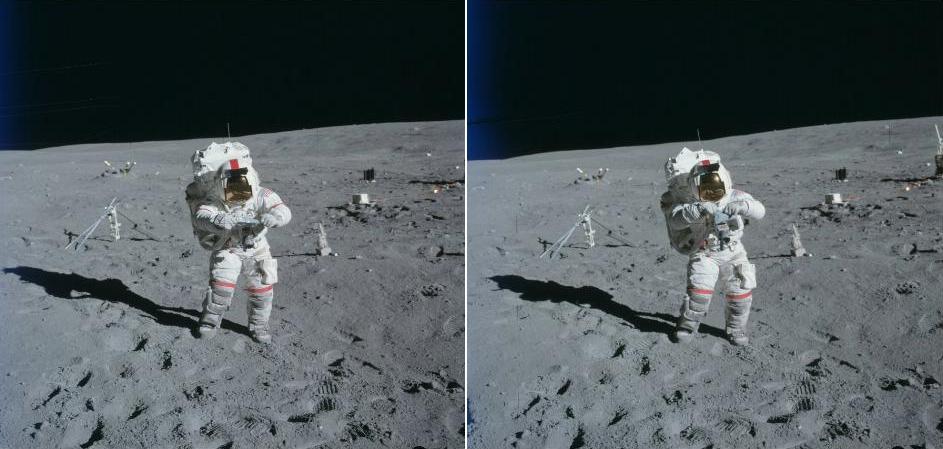 On the photos AS16-114-18387 and AS16-114-18388, the astronaut moves his hands and his head; one only understands what's funny in this sequence if he notices that the direction of the horizon line changes. If we make an animation with the two photos, it makes a funny effect. The astronaut seems to make the whole landscape rotate with a move of his arms. Now, it's not necessary abnormal, the photographer could just have turned his camera between the two shots. 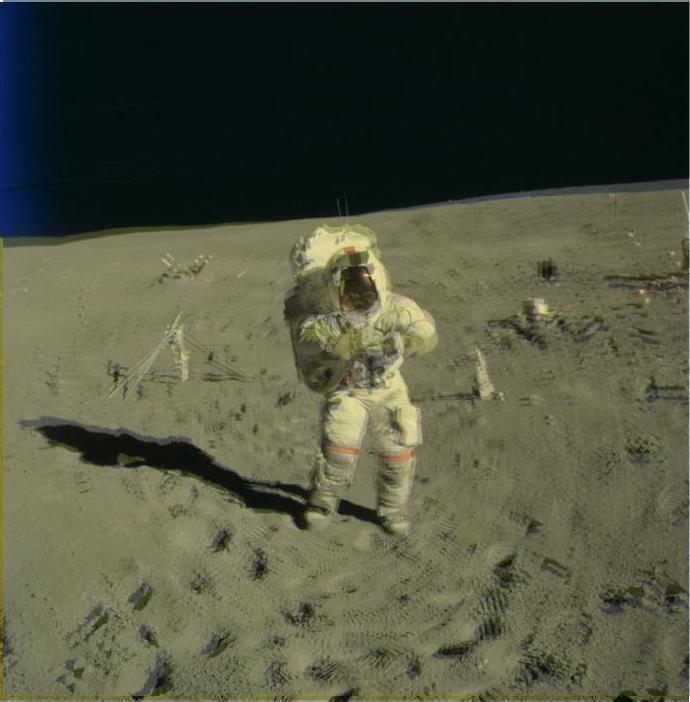 However, when I superpose the astronaut's feet on the two photos (I have colored one of the two photos to ease the superposition), I find a slight variation of the horizon line. Well, you may say: Are you sure that the feet are correctly superposed? 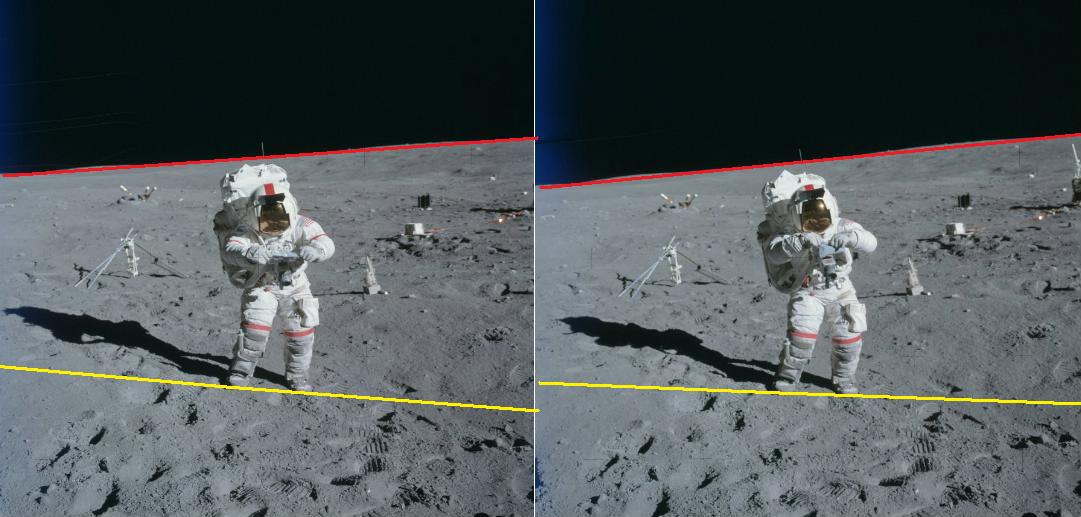 That's why I have measured another way: I have drawn a line along the extremities of the feet on the 2 photos, and measured the angle between this line and the horizon line. I find a slight variation of this angle on the two photos, not important, but existing (I have measured on print copies). In case you would contest the accuracy of my measurements, I can anyway show you facts which confirm it's a gag which is rather difficult to simulate on the moon. On this animation, I show you some rather strange particularities of the astronaut's shadow. Over the helmet, there is a strange element of shadow (I have circled in red) of which I don't see the origin. And the strap on the left of the astronaut (on his right relatively to him) makes with the backpack a window (I have circled in yellow); the problem is that, between the two photos, this window inexplicably moves down on the astronaut's shadow! The funniest part of the gag is probably this:  On the second photo, if we zoom on the astronaut, we can see in the visor the fingers of the hands of the astronaut, like his hands were turned inward. Yet, on the photo, we can see that his hands are turned outward and show their back to the visor! If the astronaut managed to do that on the moon, it's not even talent, it's magic! |
 On photos AS16-114-18422 and AS16-114-18423, the direction of the sunlight changes importantly, whereas the camera keeps aiming at the same direction. The photo AS16-114-18423 is famous because the astronaut has his shadow ahead of him and is in the same time brightly lit. The NASA contends that it comes from the lunar reflectivity! But we know better of course. It simply comes from the fact that the sun-projector is very close to the scene and diffuses its light in all directions. 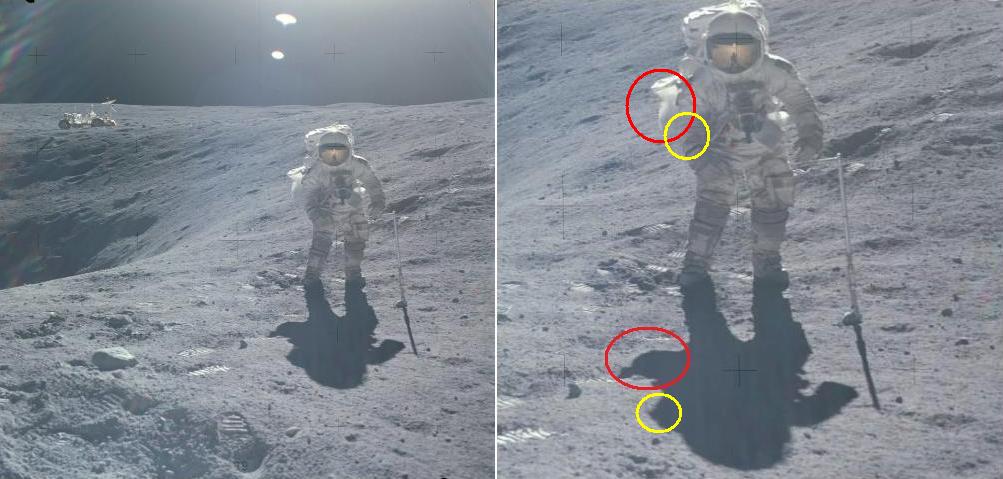 On photo AS16-114-18423 there is an object behind the astronaut's backpack of which we see the shadow (circled in red) but its shadow is too low, for it is much below the shadow of the elbow, but, on the photo, it's above this elbow 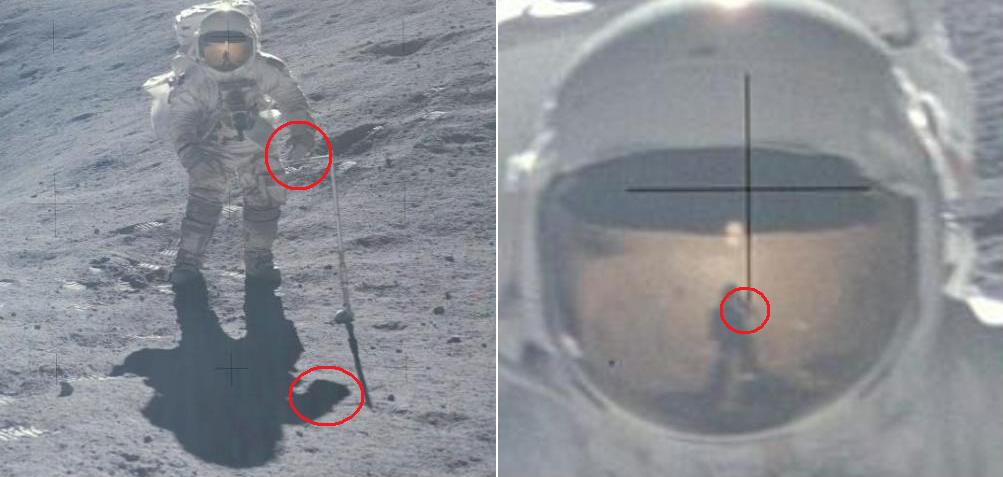 On the same photo we can see in the visor that the astronaut lifts his left arm whereas this arm is in fact lowered as much on the photo as on the shadow. The orientation of the hand of this arm on the shadow is incorrect. |
 On the photos AS16-114-18437 and AS16-114-18438, the tripod is in the shadow of the LEM. But there are windows which are lit. On the first photo, the lit window which is near the tripod has the shape of a trapezium, and on the second photo it has become a triangle! The two views are taken under different angles, but the parts of the lem's shadow are recognizable.  I have colored various parts of the lem's shadow with different corresponding colors. I have also colored the tripod's leg which points to the base of this window; the tripod has not been moved between the two photos. The two photos immediately follow each other, the sun has not changed between the two photos (besides the sun moves more slowly on the moon than it does on the earth - remember the lunar day is almost one month long). |
 On the photo AS16-114-18453, the shadow of the astronaut appears inverted: It is looking toward the rear of the rover whereas the astronaut is actually looking toward the front of the rover. We can indeed see the shadow of the helmet's edge over the visor (circled in red) and the shadow of the camera the astronaut is holding (circled in yellow). 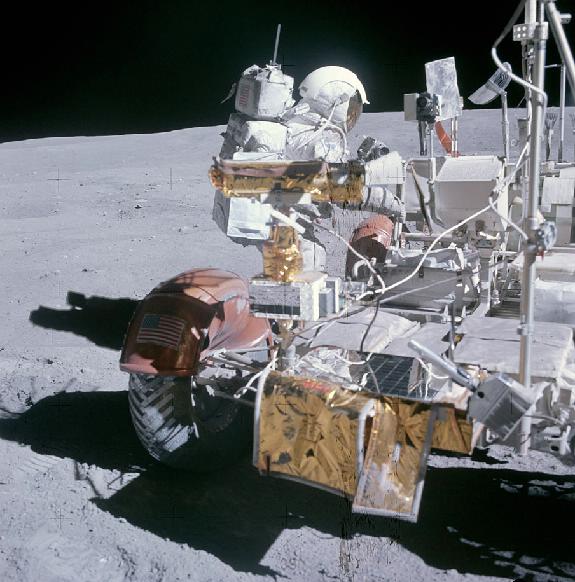 On this photo, I have corrected the shadow of the astronaut so that it is oriented the same way as its owner. Notice however that the orientation of the helmet's edge is not quite correct. |
 On photos AS16-116-18670 and AS16-116-18671, an astronaut leans against a rock. First note that the shadow of the astronaut appears like he was turned a quarter of turn clockwise. I have circled in yellow the part of the photo which is interesting. Notice also that the shadow of the astronaut appears like he was turned of a quarter of a turn clockwise.  This double view shows close-ups of the parts I have circled in yellow. You can see that there are brilliant strips which appear or disappear between the two photos. |
 On photo AS16-116-18718, there is an object on the reflection of the solar battery (I have circled in red) which is absent on the reflection of the photo AS16-116-18719!  One could say that if the object has disappeared, it's because of the change of angle of view, but it's not the case: - Look how the object I have circled in red is positioned above the two solar cells planes which are under. On the second photo, this object has pivoted and should still be visible; a part of it is still visible, but a good part of it has vanished. - On the first photo, the right side is red; on the second photo, we see the part of this side which is beyond the second solar cells plane; this part is red on the first photo, but not on the second one. - On the top of the photos, we see a couple of wires; one is straight on the first photo, and bent on the second one. |
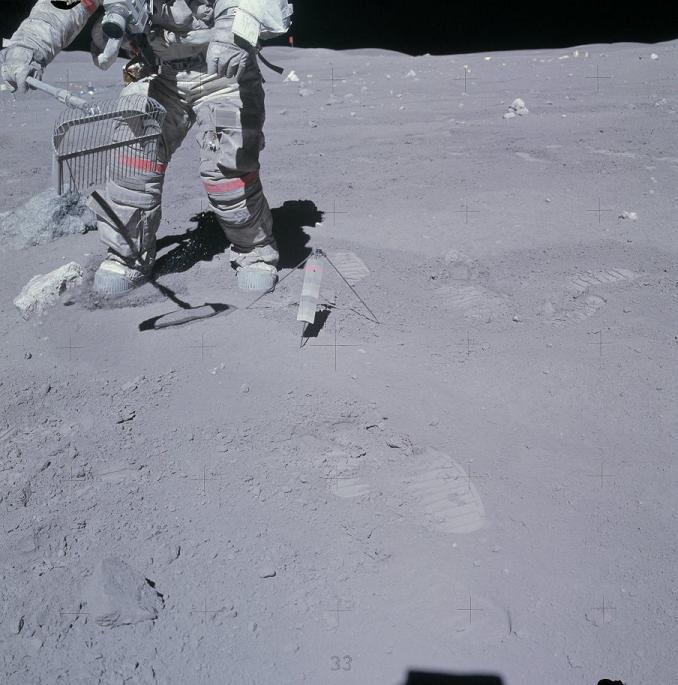 On the photo AS16-117-18826, the shadow of the brush that the astronaut is holding is incorrectly oriented. |
 The photos AS16-117-18449 and AS16-117-18450 present two views of the solar wind collector. But there is a part of the solar wind collector on which we can see drawings; I have circled this part in red on the two photos.  Here is a close-up on these drawings. Weird drawings, aren't they? |
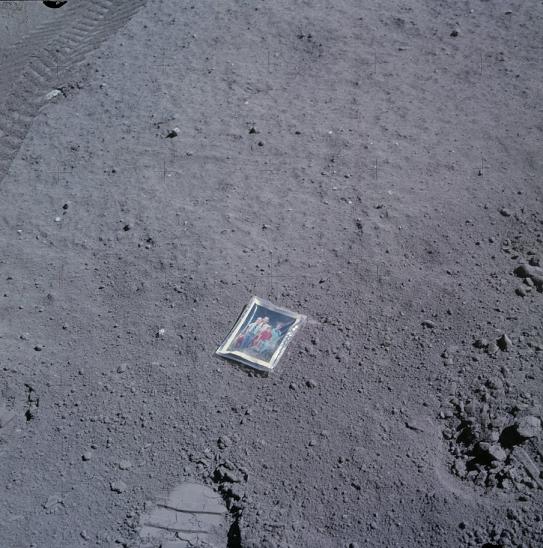 On photo AS16-117-18841, we can see a family photo lying on the ground (it would be the family of Duke). If I had wanted to leave a souvenir on the moon, it's not where I would have left it. First it could be tramped by an astronaut, and second it's exposed to the sunlight which will fade its colors (but as the sun is a big projector, this photo is safe).  But, if we look more closely at this family photo, we can see something abnormal, and even hilarious; look at the right arm of the little boy with the red sweater: It is abnormally long, it is even longer than the one of his elder brother who is yet twice taller, and much longer than his other arm. So, either the boy is a freak, or someone made a joke!  And if I rotate the family photo to set it straight, you may still better see the problem. |
 On the photo AS16-117-18852, the photographer who appears in the reflection of the visor looks very strange; he seems to have an enormous camera. |
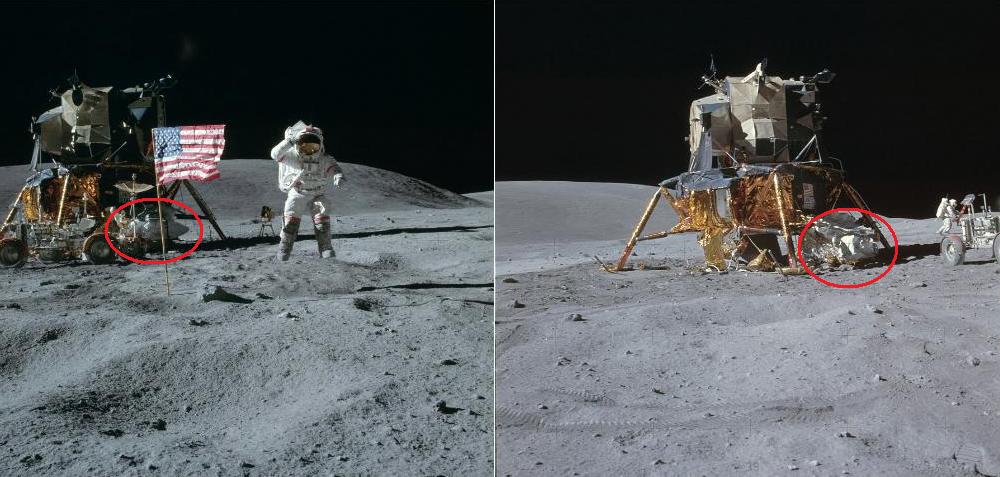 Under the LEM, there is a thermal blanket. On the photos AS16-113-18339 and AS16-107-17435, this thermal blanket (circled in red) appears differently.  On these close-ups, we can clearly see that the thermal blanket under the LEM is different on the two photos. And, I don't know if it is me, but the thermal blanket looks like an animal's head on the two photos! (BTW, I have noticed that very often the lunar rocks look like animals!). |
 On photos AS16-115-18551 and AS16-115-18552, the orientation of the horizon line changes much but there is no indication of an important change of relief in front of the rover, and the orientation of the frontal camera doesn't change. |
 On photos AS16-108-17622, the left rear wheel doesn't appear turned, but, on photo AS16-108-17623, the right rear wheel appears turned; yet the astronaut is behind the rover, may be pushing it, and he can't turn the steering wheel. |
 On photo AS16-108-17700 (right), the shadow of the astronaut diverges from the shadow of the rock and the one of the vertical stick; his lateral position is quite close to the one of the rock, so there is no reason that his shadow would consistently diverge from the one of the rock (which doesn’t diverge very much from the one of the stick). |
 On photo AS16-109-17770, we can see by the direction of the little rock I have circled in yellow that the sun is coming from the left side of the camera; yet its right side is not shaded. |
 On photo AS16-109-17391 (right), the horizon line has rotated relatively to the previous photo AS16-109-17390 (left), but the direction of the rover has not changed, and the position of stones in the close foreground relatively to the rover has not changed either, which shows that the photographer has not moved. A new example of background rotating and foreground not rotating, a classic of the fakers. |
 On photo AS16-109-18700 (right), we can see that the stones in the foreground have moved on the right relatively to the background; thence the photographer has moved on the left; the vertical stick should have rotated clockwise relatively to the (yellow) horizon line, but it has rotated counterclockwise instead (of course I didn't measure on the picture I present). |
This animation is made with the photos AS16-115-18559 and AS16-115-18561. The animation is the best way to see what's weird with these two photos. Look on the extreme left of the horizon: You will see a bit of hill which doesn't rotate with the rest. It's like the whole scene was rotating around this hill. In case you wouldn't very well see this not rotating hill bit, I have made a an zoomed animation. |
 On photos AS16-113-18331 and AS16-113-18332, on the part of the lem I have circled in red, and of which I show close-ups in windows, you can see that there is an element which is different. |
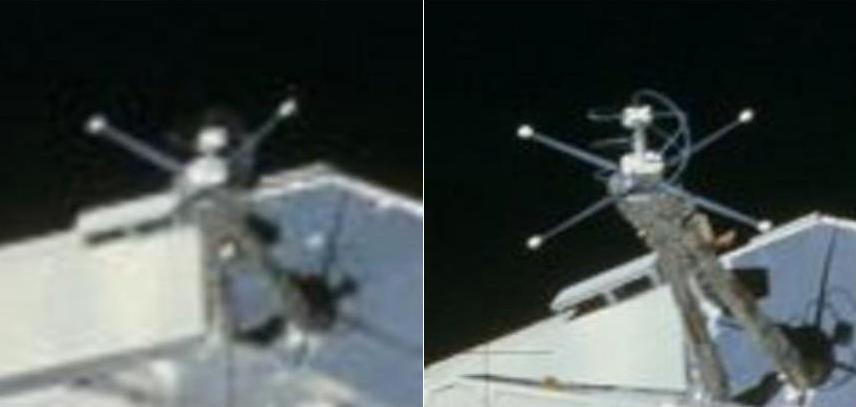 this double view shows two close-ups of the same device on the photos AS16-113-18329 and AS16-113-18331. On the second close-up, there is a branch of the device which is parallel to the edge of the lem's top...But on the first close-up, that same branch is not and makes an angle with this edge! |
 On photo AS16-113-18359, when we take a close-up at the lem in the distance, it looks like it was sinking in a lunar ocean; yet on other photos, it's not hidden by the relief. |
 On AS16-117-18816 (right), the lem we see in the distance has an element (I have circled in red) which is different from the same element on AS16-116-18579 (left). |
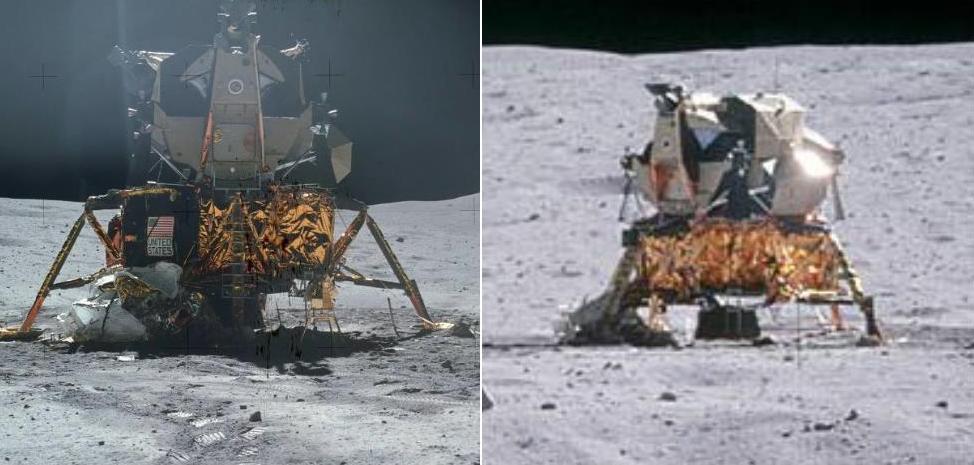 And on photo AS16-114-18455 (right) , the lem looks quite strange! |
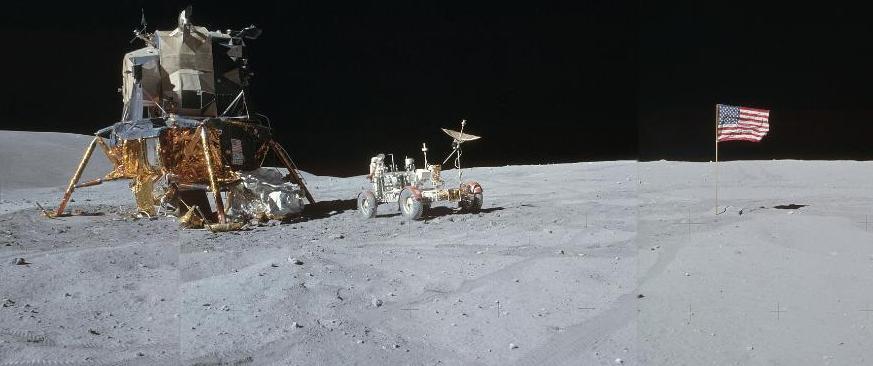 I have made this panorama with the photos AS16-107-17435, AS16-107-17437 and AS16-107-17439 of Apollo 16. 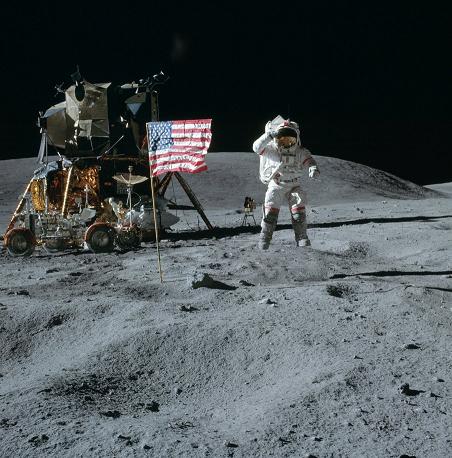 When we compare this panorama with the photo of the astronaut jumping, the LM does not seem to be at the same distance at all. Now, you are going to say: Prove it. It may not be so easy to prove, but there is something easier to prove. 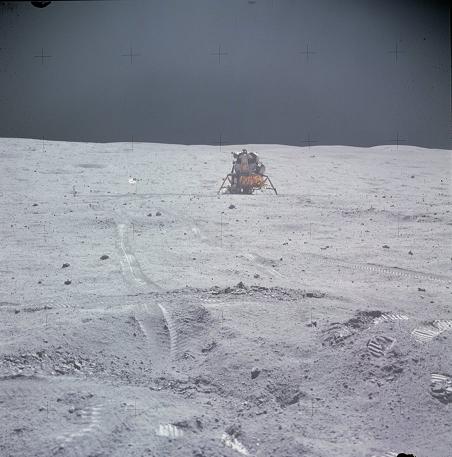 On the photo AS16-117-18815 we can see the LM and the flag in the distance under the same perspective as my panorama, just in opposite. 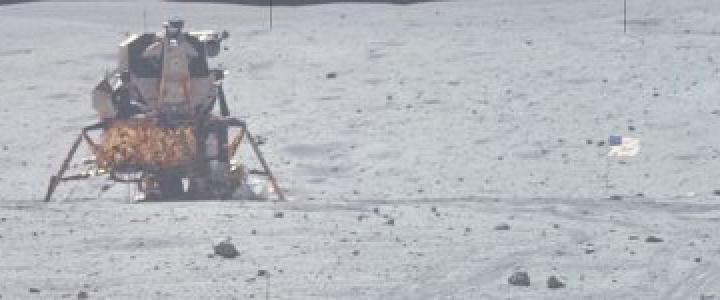 I have extracted an equivalent part, and I have inverted it horizontally to have the flag on the same side relatively to the LM. 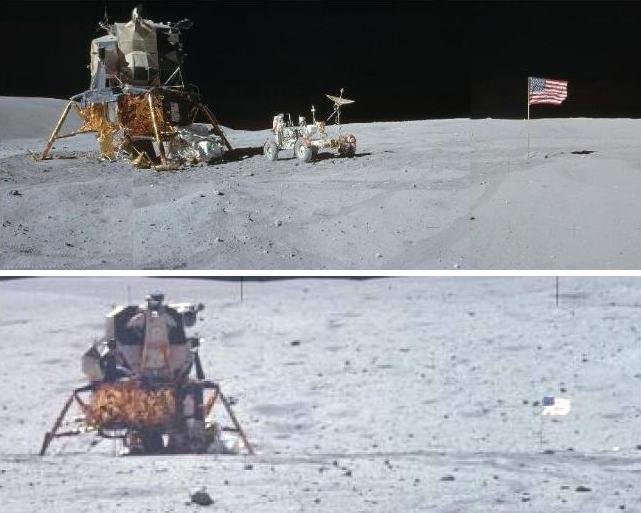 If we compare the panorama I have made with the part I have extracted from the photo (and inverted horizontally), we can see that the size of the flag relatively to the LM is very different on the two views. Would the flag have shrunk along the mission. If it continues to shrink, I'm afraid it will completely disappear! And that's now all, notice that, although the flag is on the right of the lunar module on the two views, the lunar module is oriented differently! |
 On photo AS16-118-18602 (right), we can see that the closest rock of a group of three rocks in the foreground has moved on the left relatively to those which are behind; therefore the photographer has moved on the right; consequently the direction of the rocks (red line) should have rotated clockwise relatively to the (yellow) reference line of the background, and it has rotated counterclockwise instead. |
 On photo AS16-116-18697, the bar I have circled in red has a too long shadow; it obviously stops before its shadow. |
 On photo AS16-116-18708, the legs of the tripod are in the shadow of the lem, and yet they appear lit. |
 On this photo, AS16-117-18818, we can also see lit parts on the shadow of the wheel because of the open mesh wire of the tire tread... 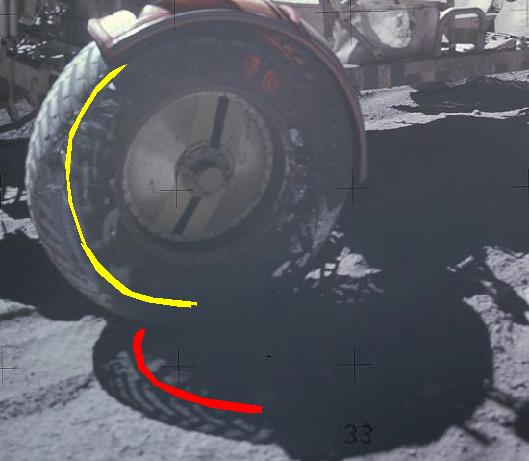 I have drawn in yellow the separation between the part of the tire which rolls on the ground and the lateral part of the tire, it is easy to locate the shadow of this separation on the ground, for the opaque bars are not oriented the same; those which are on the side are radial. And we can see that the shadow of this separation is not correct, for it arrives incorrectly relatively to the shadow of the fender. |
 On photo AS16-117-18819, why can't we see at all the shadow of the astronaut that we see working in front of the rover? |
 On photo AS16-107-17459 (left) we can see a vertical pole (with a double handle) and furthermore the shadow of this pole we can also see the shadow of a pole which is behind. On photo AS16-107-17460 (right) we can now see the vertical pole which is behind and was hidden on the previous photo, but we can no more see its shadow! |
 This is a part of photo AS16-106-17340. First anomaly: On the photo, the upper end of the brush the astronaut is holding is at some distance from his head...but on the shadow, it's quite close to it. Second anomaly: Where is the shadow of the astronaut's backpack??? |
 This is a part of photo AS16-106-17393. The bit of shadow I have circled is inexplicable. It can't belong to the rock's shadow. |
 This is a part of photo AS16-106-17490. The tripod of this photo has no top...on another photo, it had one, what has happened to it? |
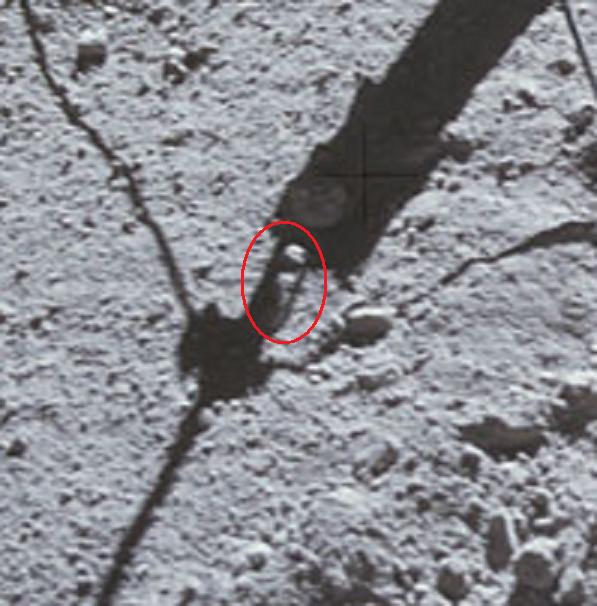 This is a part of photo AS16-107-17490. There is a little rock which is crossed by the tripod's shadow...and yet it remains lit! |
 This is a part of photo AS16-107-17526. On the shadow of the stick the astronaut is holding, we don't see the shadow of the astronaut's hand at the end of this shadow. You might say: Are you sure that it is really the end of this shadow, that it is not interrupted? Yes, I'm sure it's the end of its shadow for the following reason: On the right of this stick there is another stick which is just a little smaller, and we see its shadow which is a little shorter than the first stick's shadow. And we can be sure of the end of the shadow of the second stick, for we can see the shadow of the transversal double bar which is at the top of this stick. |
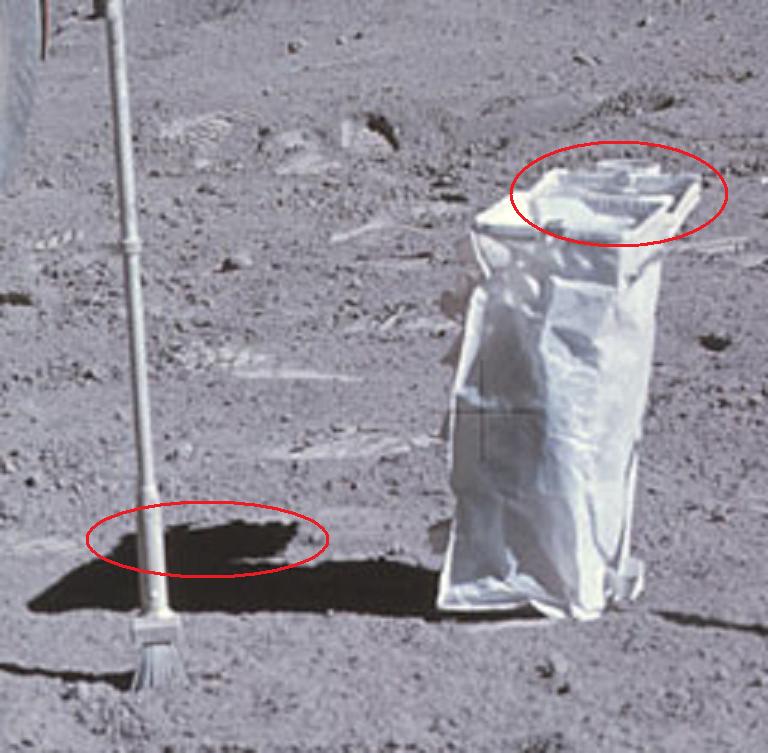 This is a part of photo AS16-107-17537. On this photo we can see a sort of bag and its shadow; the shadow of the part of the bag I have circled is incorrect; its shadow is too thick. |
 This is a part of photo AS16-107-17552. We can see the shadow of the upper end of something the astronaut is holding...but on the photo we can't see the lower end of this something. |
 This is a part of photo AS16-108-17629. On the photo we can see that there is a stick which comes right into the astronaut's left hand (at the place I circled in yellow)...but on the shadow, we can see a part of the shadow of this same stick (on the place I circled in red), and we can perfectly see that it arrives on the astronaut's right arm and not his left hand. |
 This is a part of photo AS16-108-17670. The shadow of the astronaut appears like he was close to the rover, but on the photo he is a little separated from it. |
 This is a part of photo AS16-108-17702. The top of the astronaut's shadow is obviously incorrect. |
 This is a part of photo AS16-110-17948. On the shadow we can perfectly see the shadow of the camera's lens. But on the photo itself, we can see that there is a paper behind the camera (or what looks like one), and we can even see the shadow of the camera's lens on this paper; therefore, it's not the shadow of the camera's lens we should see on the "lunar" ground, but the shadow of this paper. |
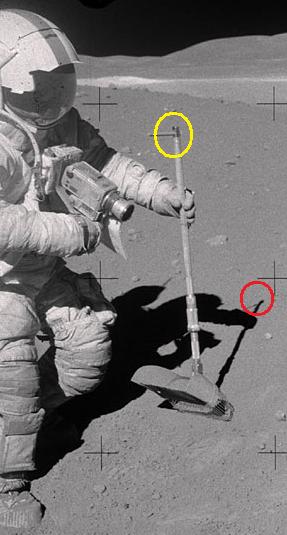 This is a part of photo AS16-110-18019. On the photo, the upper end of the brush the astronaut is holding is quite lower than his head...but the upper end of the brush's shadow comes as high as the astronaut's head! |
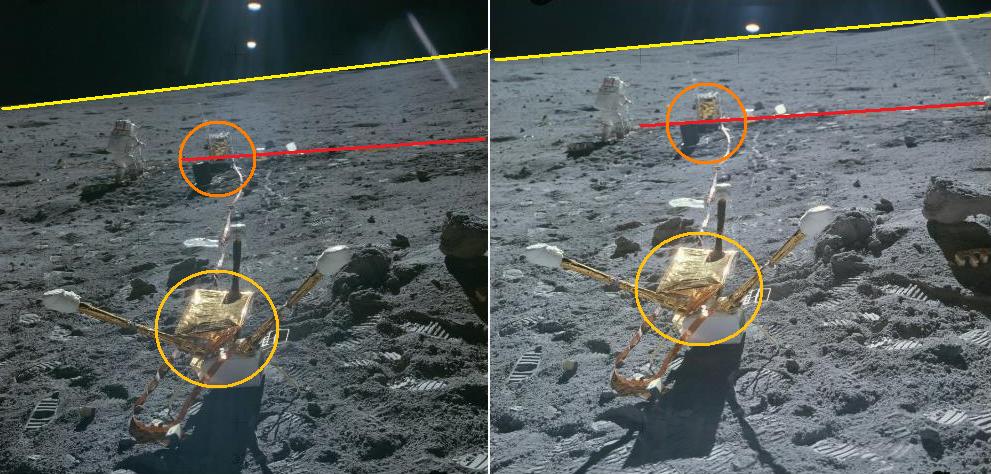 On photo AS16-113-18374 (right), the magnetometer in the close foreground has slightly moved on the left relatively to the ALSEP; the photographer has moved on the right, and the ribbon should have rotated clockwise relatively to the (yellow) horizon line, but it has rotated counterclockwise instead. Background and foreground rotating in opposite directions, the very favorite of the fakers, the most used trick! |
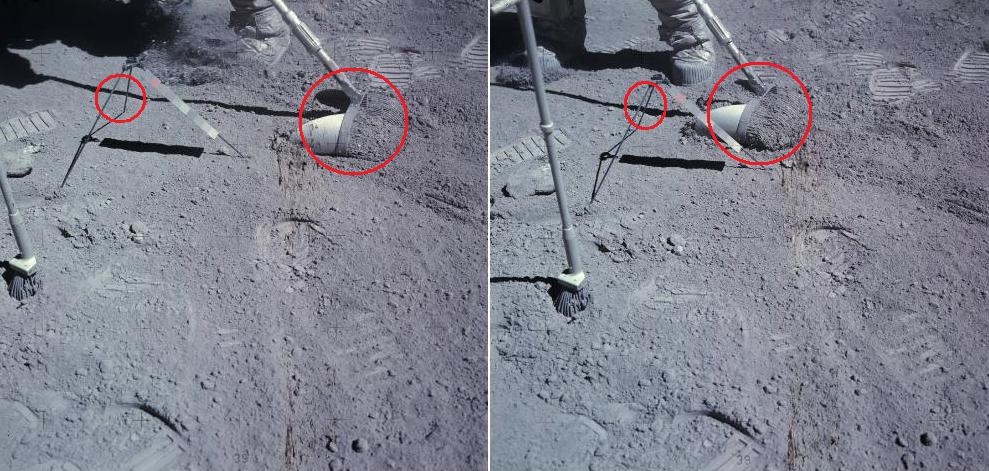 On photo AS16-113-18666 (right), if we consider the position of a leg of the tripod relatively to the shadow of the brush's handle, and the position of the brush relatively to its handle, it's obvious that the brush is about to bump into this leg; and the astronaut makes no effort to divert this brush; he really has no consideration for the poor tripod! |
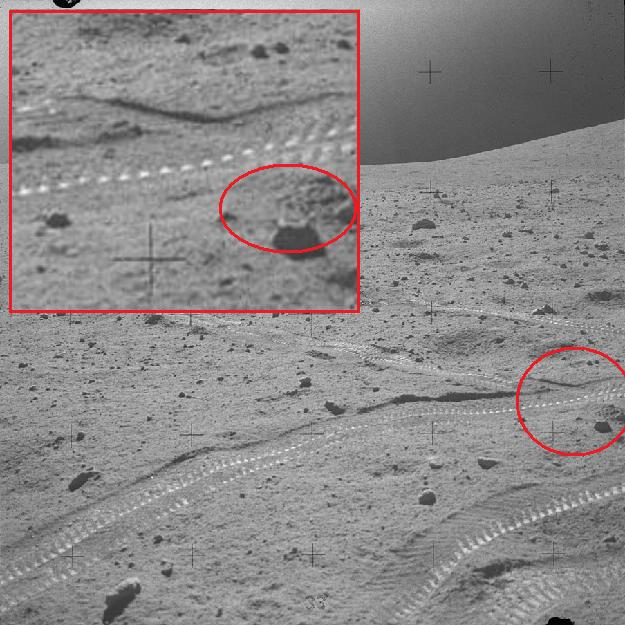 On photo AS16-108-17617 we see another pair of rover tracks on the left of the first pair, but the latter brutally stops on the first pair, and doesn't seem to go beyond. Yet, it's impossible that the rover could switch from the first pair to the second pair under this impossible angle. |
 Sometimes we can see strange things which seem carved in rock; such is the case on this photo (AS15-106-17342); I have colored in pink the face which seems to emerge from the rock. |
 There are two close-ups of the rover with an astronaut on the side of the rover: AS16-108-17744 (left on the double view) and AS16-115-18472 (right on the double view).  On this double view I have circled with different colors several parts worthy of interest. 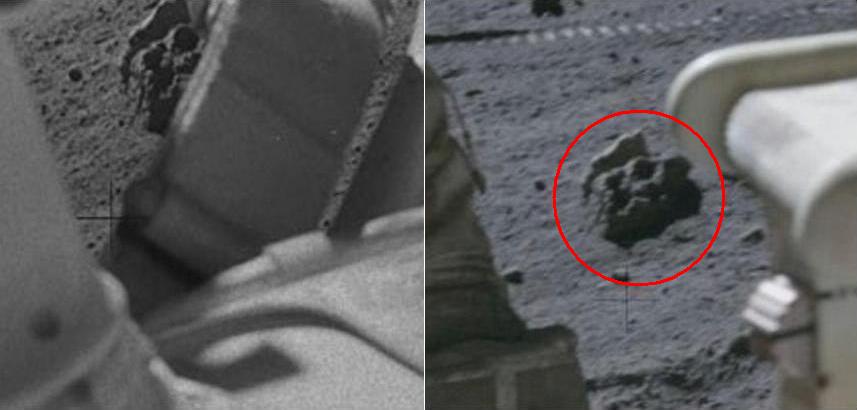 This double view shows close-ups of a part of the photos on which we can see a weird rock (circled in white on the general view). This rock has a very strange shape; it allows to know how the photographer has moved between the two views, by locating this rock relatively to the rover on the two views: The photographer has moved up and on the left.  This double view shows close-ups of the saddle on the two views (that I have circled in red on the general view). By examining the shadows, we can see that the sun is shining from the rear; on the second view, the way the saddle is lit seems logical; but on the first view, the part of the saddle which is brilliantly lit is the left part of the saddle; it's illogical, given the way the sun is shining (from the rear); moreover we can see that the left side of the rover is in the shadow, and there is some light on its right side.  This double view shows close-ups of the bottom of the handle of the two photos (that I have circled in violet on the general view). We can see that the foot of the handle is lower on the second view that it is on the first view.  This double view shows two close-ups of a marking on the handle (circled in yellow on the general view). We can see a 'R' on the right of a dash. Of the left view, the 'R' is as thick and clear as the dash. On the right view, may be the top of the 'R' is hidden by the handle, but we can see its bottom, and it should be as thick and clear as the dash, but it isn't; it's half erased.  These are close-ups of what's under the saddle (circled in green on the general view). On the right view we can see an element (I have circled) which is absent of the left view.  Still lower there is a metallic ring (circled in orange on the general view) of which I show close-ups on the two photos. On the second photo, the metallic ring is doubled with a second smaller ring (I have circled) we can't see on the first photo. 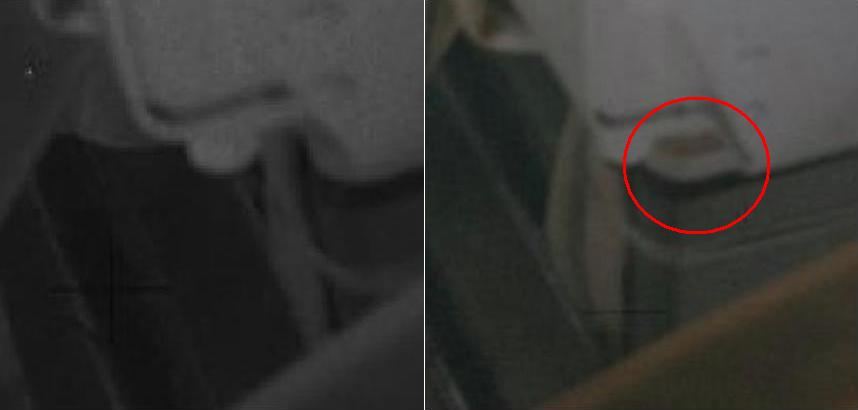 On this double view, I show close-ups of the bottom of the white plastic box (circled in brown on the general view). On the left view we can see an element (I have circled) which is absent on the first view. 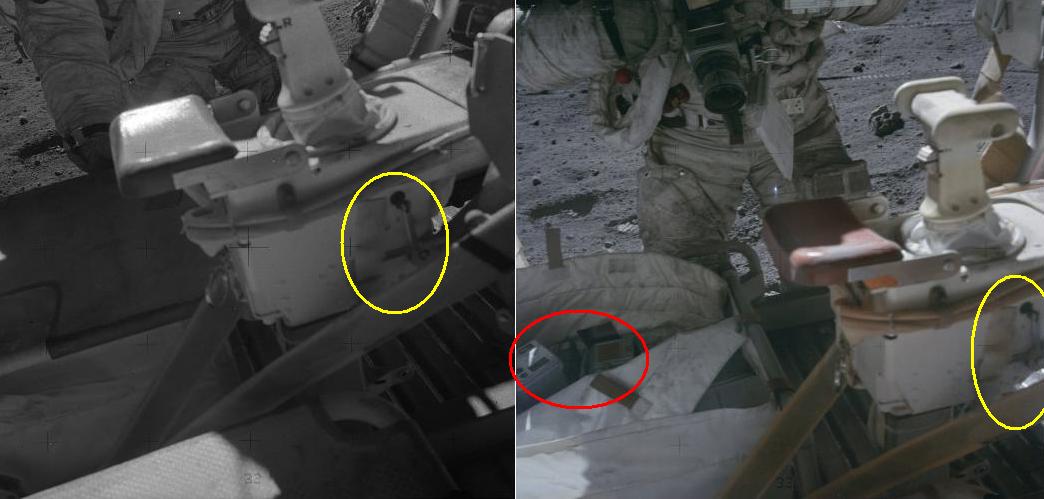 I have circled other parts on the two photos which are also worthy of interest.  On this double view, I show close-ups of a vertical lever which is connected to the white box (circled in yellow on the new general views). Obviously, the purpose of this lever is to be turned, probably to change gear). But see how it is fixed! How can it turn the way it is fixed??? 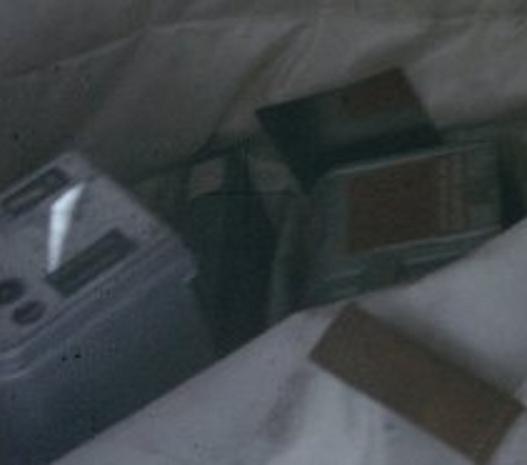 Finally, the cherry on the cake: On the second view, the astronaut has removed a cover which was hiding electronic devices (circled in red). I show here a close-up of these devices. We can see a small oscilloscope and an electronic measure device. Both have small displays and are less than ideally placed for the visualization. What might these electronic devices be useful to, but, most important, How could the astronauts see their display when they couldn't even see their cameras??? |